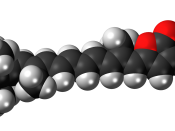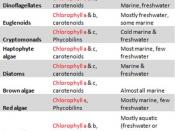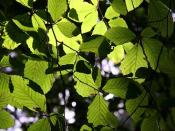Biology: Chromatography and Chlorophyll Analysis
Questions and Observations:
1.
2 How many different color bands do you see on your chromatogram?
Remember that every spot of color regardless if it's the same color is another spot is a different pigment. (Note: that green at the starting point that remains is different from the other greens that ere soluble and moved with the solvent front") Use the information below to help you identify the different pigments you have on your chromatogram. List them in your answer.
Pigments Color
Chlorophyll a = Green
Chlorophyll b = Greenish-blue
Carontenes = Orange
Xanthophylls = Yellow
I see there are 5 different color bands I see the pigment from juice and 4 soluble pigments
2.Based solely on the size of the spot/band, which pigment as the most abundant?
Greenish-Blue
Analysis:
1.How do you know that plants do not use energy protons with wavelengths between 530-60nm?
Because those wavelengths are what the plants lacks.
It absorbs every color but those wavelengths, which to the human eye reflects the colors not being absorb.
2.Summarize the purpose/function of a photosynthetic pigment like Chlorophyll a and b? What do they do and how do they work?
It absorbs light in blue and red regions and since light is a form of energy. The light transforms it to electrons and raises the molecule, which allows it to do photosynthesis.
3.According to the reading on the graph, what colors are actually absorbed but chlorophylls a and b?
Chlorophyll a = ABSORBS VIOLET AND RED and
Chlorophyll b = ABSORBS BLUE AND RED REGION
4.Explain the purpose/advantages for a plant having both types of chlorophylls. Remember that a plant want to do photosynthesis.
Its advantages is that it is able to do photosynthesis at night because it's...


